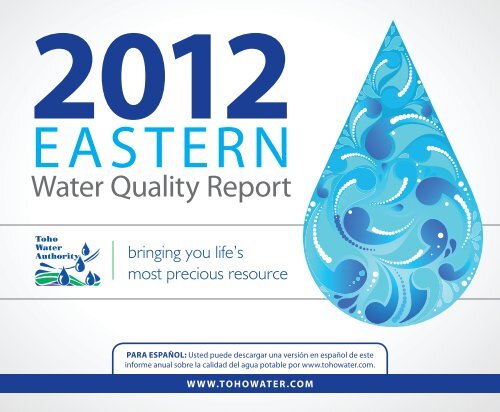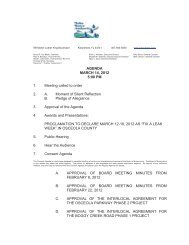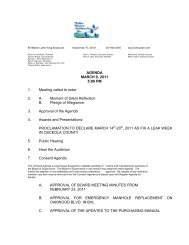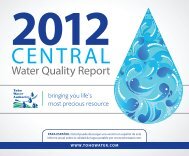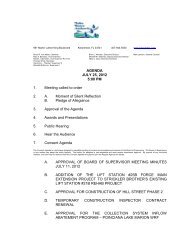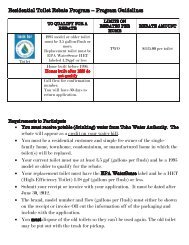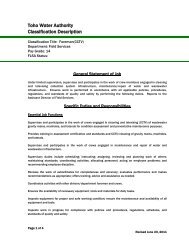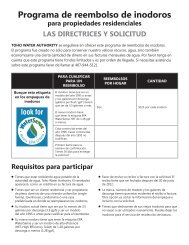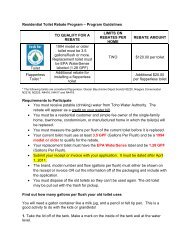Eastern Report - Toho Water Authority
Eastern Report - Toho Water Authority
Eastern Report - Toho Water Authority
You also want an ePaper? Increase the reach of your titles
YUMPU automatically turns print PDFs into web optimized ePapers that Google loves.
2012<br />
eastern<br />
<strong>Water</strong> Quality <strong>Report</strong><br />
Para español: Usted puede descargar una versión en español de este<br />
informe anual sobre la calidad del agua potable por www.tohowater.com.<br />
www.tohowater.com
The <strong>Toho</strong>pekaliga (tOHO) <strong>Water</strong> <strong>Authority</strong><br />
1<br />
The <strong>Toho</strong>pekaliga <strong>Water</strong> <strong>Authority</strong> delivers to you water that is constantly tested for compliance with federal and state standards<br />
and regulations. During the period of January 1st to December 31st 2012 covered by this Consumer Confidence <strong>Report</strong>, highly trained<br />
scientists and technicians performed analyses on samples taken throughout your water system. The results of these analyses showed<br />
that the substances for which the <strong>Toho</strong>pekaliga <strong>Water</strong> <strong>Authority</strong> is required to test, most were found to be at levels in the water<br />
substantially lower than the minimum acceptable levels. This brochure is a summary of the water quality provided to our customers. It<br />
is a record reflecting the hard work of our employees to bring you high quality water.<br />
An Explanation of the <strong>Water</strong>-Quality Data Table<br />
The table shows the results of our water-quality analyses. Every regulated contaminant that<br />
we detected in the water, even in the most minute traces, is listed here. The table contains<br />
the name of each substance, the highest level allowed by regulation (MCL), the ideal goals<br />
for public health, the amount detected, the usual sources of such contamination, footnotes<br />
explaining our findings, and a key to units of measurement.<br />
As authorized and approved by EPA, the State has reduced monitoring requirements for<br />
certain contaminants to less often than once per year because the concentrations of these<br />
contaminants are not expected to vary significantly from year to year. Some of our data,<br />
though representative, is more than one year old.<br />
Key To Tables<br />
AL = Action Level<br />
ND = Not Detected<br />
N/A = Not Applicable<br />
RAA = Running Annual Average<br />
<strong>Water</strong> Source<br />
Underneath Osceola County<br />
lies one of the largest<br />
pristine reservoirs of fresh<br />
groundwater in the country,<br />
the Floridian Aquifer. <strong>Water</strong><br />
from this aquifer is of<br />
consistently high quality and is<br />
used as the source of potable<br />
water for the <strong>Toho</strong>pekaliga<br />
<strong>Water</strong> <strong>Authority</strong> water system.<br />
The aquifer is recharged by<br />
rainfall on the Lake Wales<br />
Ridge (US 27) in Osceola,<br />
Polk and Lake Counties that<br />
is filtered through hundreds<br />
of feet of sand and rock in<br />
a natural cleansing process.<br />
Because of its high quality,<br />
the water we use needs little<br />
or no treatment other than<br />
aeration to remove hydrogen<br />
sulfide (rotten egg odor) and<br />
is chlorinated for disinfection.
<strong>Toho</strong> <strong>Water</strong> <strong>Authority</strong> Service Area<br />
2<br />
Western<br />
southern<br />
Central<br />
<strong>Eastern</strong><br />
A - Hidden Glen<br />
B - Western<br />
C - Intercession City<br />
D - Poinciana<br />
E - Pleasant Hill<br />
Lakes<br />
F - <strong>Eastern</strong><br />
G - Buenaventura<br />
Lakes<br />
H - Springlake<br />
Village<br />
I - Lake Ajay<br />
Estates<br />
J - Bay Lake Estates<br />
K - Harmony<br />
B<br />
W. Osceo<br />
la Pkwy.<br />
E. Osceola Pkw y.<br />
H<br />
I<br />
4<br />
Celebration<br />
192<br />
C<br />
N. Poinciana Blvd.<br />
W<br />
.<br />
Irlo Bronson Memorial Hwy.<br />
Kissimmee<br />
Municipal<br />
Airport<br />
F<br />
92<br />
N. John Young Pkwy.<br />
92<br />
17<br />
441<br />
Kissimmee<br />
Boggy Creek Rd.<br />
Fortune Rd.<br />
192<br />
Neptune Rd.<br />
G<br />
Boggy Creek Rd.<br />
East Lake<br />
<strong>Toho</strong>pekaliga<br />
N. Narcoossee Rd.<br />
A<br />
92<br />
S. Orange Blosso m Trail<br />
17<br />
St. Cloud<br />
192 441<br />
Nova Rd.<br />
Florida Turnpike<br />
W. Irlo Bronson Memorial Hwy.<br />
17<br />
S. Poinciana Blvd.<br />
Pleasant Hill Rd.<br />
E<br />
Lake<br />
<strong>Toho</strong>pekaliga<br />
Hickory Tree Rd.<br />
J<br />
K<br />
Harmony<br />
nport<br />
92<br />
D<br />
Poinciana<br />
Cypress Pkwy.
Springlake Village <strong>Water</strong> System (PWS ID# 349-4418) 3<br />
INORGANIC CONTAMINANTS<br />
Contaminant<br />
and Unit of<br />
Measurement<br />
Dates of<br />
sampling<br />
(mo/yr)<br />
MCL<br />
Violation<br />
Y/N<br />
Level<br />
Detected<br />
Range of<br />
Results<br />
Barium (ppm) 3/12 N 0.022 N/A 2 2<br />
Fluoride (ppm) 3/12 N 0.54 N/A 4 4.0<br />
Lead (point of<br />
entry) (ppb)<br />
Nitrate (as<br />
Nitrogen) (ppm)<br />
3/12 N 0.9 N/A N/A 15<br />
2/12, 3/12 N 0.052 0.031-0.052 10 10<br />
MCLG MCL Likely Source of Contamination<br />
Discharge of drilling wastes; discharge from metal<br />
refineries; erosion of natural deposits<br />
Erosion of natural deposits; discharge from fertilizer<br />
and aluminum factories. <strong>Water</strong> additive which<br />
promotes strong teeth when at the optimum level<br />
of 0.7 ppm<br />
Residue from man-made pollution such as auto<br />
emissions and paint; lead pipe, casing, and solder<br />
Runoff from fertilizer use; leaching from septic<br />
tanks, sewage; erosion of natural deposits<br />
Sodium (ppm) 3/12 N 51.6 N/A N/A 160 Salt water intrusion, leaching from soil<br />
Volatile Organic Contaminants<br />
Contaminant<br />
and Unit of<br />
Measurement<br />
Xylenes (ppm)<br />
Dates of<br />
sampling<br />
(mo/yr)<br />
5/12, 9/12,<br />
10/12<br />
MCL<br />
Violation<br />
Y/N<br />
Level<br />
Detected<br />
Range of<br />
Results<br />
N 0.0065 ND-0.0065 10 10<br />
MCLG MCL Likely Source of Contamination<br />
Synthetic Organic Contaminants including Pesticides and Herbicides<br />
Contaminant and Unit<br />
of Measurement<br />
Dalapon (ppb)<br />
Dibromochloropropane<br />
(DBCP) (nanograms/l)<br />
Dates of<br />
sampling<br />
(mo/yr)<br />
4/12, 9/12,<br />
10/12<br />
4/12, 9/12,<br />
10/12<br />
MCL<br />
Violation<br />
Y/N<br />
Level<br />
Detected<br />
Range of<br />
Results<br />
Discharge from petroleum factories; discharge from<br />
chemical factories<br />
MCLG MCL Likely Source of Contamination<br />
N 1.9 ND-1.9 200 200 Runoff from herbicide used on rights of way<br />
N 71 ND-71 0 200<br />
Runoff/leaching from soil fumigant used on<br />
soybeans, cotton, pineapples, and orchards
Springlake Village <strong>Water</strong> System (PWS ID# 349-4418) continued<br />
4<br />
Stage 1 Disinfectants and Disinfection By-Products<br />
Disinfectant or<br />
Contaminant<br />
and Unit of<br />
Measurement<br />
Dates of<br />
sampling<br />
(mo/yr)<br />
MCL or<br />
MRDL<br />
Violation<br />
Y/N<br />
Level<br />
Detected<br />
Range of<br />
Results<br />
MCLG or<br />
MRDLG<br />
MCL or<br />
MRDL<br />
Likely Source of Contamination<br />
Chlorine (ppm) 1/12-12/12 N 1.2 (RAA) 0.4-1.8 MRDLG = 4 MRDL = 4.0 <strong>Water</strong> additive used to control microbes<br />
Haloacetic Acids<br />
(five) [HAA5] (ppb)<br />
Total<br />
Trihalomethanes<br />
[TTHM] (ppb)<br />
7/12 N 47.3 N/A N/A MCL = 60 By-product of drinking water disinfection<br />
7/12 N 79.3 N/A N/A MCL = 80 By-product of drinking water disinfection<br />
Lead and Copper (Tap <strong>Water</strong>)<br />
Contaminant<br />
and Unit of<br />
Measurement<br />
Dates of<br />
sampling<br />
(mo/yr)<br />
AL<br />
Exceeded<br />
Y/N<br />
90th<br />
Percentile<br />
Result<br />
No. of sampling<br />
sites exceeding<br />
the AL<br />
MCLG<br />
AL<br />
(Action<br />
Level)<br />
Likely Source of Contamination<br />
Copper (tap<br />
water) (ppm)<br />
Lead (tap water)<br />
(ppb)<br />
1/12-12/12 N 0.25 0 1.3 1.3<br />
1/12-12/12 N 2.3 1 0 15<br />
Corrosion of household plumbing systems;<br />
erosion of natural deposits; leaching from<br />
wood preservatives<br />
Corrosion of household plumbing<br />
systems, erosion of natural deposits<br />
Source <strong>Water</strong> Assessment Information<br />
In 2012 the Department of Environmental Protection performed a Source <strong>Water</strong> Assessment on our system. The assessment was conducted to<br />
provide information about any potential sources of contamination in the vicinity of our wells. There were no potential sources of contamination near<br />
our well. The assessment results are available on the FDEP Source <strong>Water</strong> Assessment and Protection Program website at www.dep.state.fl.us/swapp.<br />
Check your toilet for leaks – One way to find out if you have a toilet leak is to place a drop<br />
of food coloring in the toilet tank. If the color shows up in the bowl within 15 minutes without flushing, you<br />
have a leak. Make sure to flush immediately after this experiment to avoid staining the tank. You can also stop<br />
by <strong>Toho</strong>’s Main Office (951 MLK Blvd, Kissimmee) and pick up free dye test tablets.
Bay Lake Estates <strong>Water</strong> System (PWS ID# 349-0090)<br />
5<br />
INORGANIC CONTAMINANTS<br />
Contaminant<br />
and Unit of<br />
Measurement<br />
Dates of<br />
sampling<br />
(mo/yr)<br />
MCL<br />
Violation<br />
Y/N<br />
Level<br />
Detected<br />
Range of<br />
Results<br />
MCLG MCL Likely Source of Contamination<br />
Barium (ppm) 3/12 N 0.0051 N/A 2 2<br />
Fluoride (ppm) 3/12 N 0.19 N/A 4 4.0<br />
Nitrate (ppm) 2/12, 3/12 N 0.049 0.046-0.049 10 10<br />
Discharge of drilling wastes; discharge from metal<br />
refineries; erosion of natural deposits<br />
Erosion of natural deposits; discharge from fertilizer<br />
and aluminum factories. <strong>Water</strong> additive which<br />
promotes strong teeth when at the optimum level of<br />
0.7 ppm<br />
Runoff from fertilizer use; leaching from septic tanks,<br />
sewage; erosion of natural deposits<br />
Sodium (ppm) 3/12 N 24.4 N/A N/A 160 Salt water intrusion, leaching from soil<br />
Synthetic Organic Contaminants including Pesticides and Herbicides<br />
Contaminant and Unit<br />
of Measurement<br />
Dibromochloropropane<br />
(DBCP) (nanograms/l)<br />
Stage 1 Disinfectants and Disinfection By-Products<br />
Disinfectant or<br />
Contaminant<br />
and Unit of<br />
Measurement<br />
Dates of<br />
sampling<br />
(mo/yr)<br />
MCL or<br />
MRDL<br />
Violation<br />
Y/N<br />
Level<br />
Detected<br />
Range of<br />
Results<br />
MCLG or<br />
MRDLG<br />
MCL or<br />
MRDL<br />
Likely Source of Contamination<br />
Chlorine (ppm) 1/12-12/12 N 1.5 (RAA) 0.3-2.2 MRDLG = 4 MRDL = 4.0 <strong>Water</strong> additive used to control microbes<br />
Haloacetic Acids<br />
(five) [HAA5] (ppb)<br />
Total<br />
Trihalomethanes<br />
[TTHM] (ppb)<br />
Dates of<br />
sampling<br />
(mo/yr)<br />
4/12, 9/12,<br />
10/12<br />
MCL<br />
Violation<br />
Y/N<br />
Level<br />
Detected<br />
Range of<br />
Results<br />
N 55 ND-55 0 200<br />
MCLG MCL Likely Source of Contamination<br />
Runoff/leaching from soil fumigant used on<br />
soybeans, cotton, pineapples, and orchards<br />
7/12 N 47.7 N/A N/A MCL = 60 By-product of drinking water disinfection<br />
7/12 N 74.4 N/A N/A MCL = 80 By-product of drinking water disinfection
Bay Lake Estates <strong>Water</strong> System (PWS ID# 349-0090) continued<br />
6<br />
Lead and Copper (Tap <strong>Water</strong>)<br />
Contaminant<br />
and Unit of<br />
Measurement<br />
Dates of<br />
sampling (mo/<br />
yr)<br />
AL<br />
Exceeded<br />
Y/N<br />
90th<br />
Percentile<br />
Result<br />
No. of sampling<br />
sites exceeding<br />
the AL<br />
MCLG<br />
AL<br />
(Action<br />
Level)<br />
Likely Source of Contamination<br />
Copper (tap<br />
water) (ppm)<br />
Lead (tap water)<br />
(ppb)<br />
1/10-12/10 N 0.5 0 1.3 1.3<br />
1/10-12/10 N 2.4 0 0 15<br />
Corrosion of household plumbing<br />
systems; erosion of natural deposits;<br />
leaching from wood preservatives<br />
Corrosion of household plumbing<br />
systems, erosion of natural deposits<br />
Source <strong>Water</strong> Assessment Information<br />
In 2012 the Department of Environmental Protection performed a Source <strong>Water</strong> Assessment on our system. The assessment was conducted to<br />
provide information about any potential sources of contamination in the vicinity of our wells. There were no potential sources of contamination near<br />
our wells. The assessment results are available on the FDEP Source <strong>Water</strong> Assessment and Protection Program website at www.dep.state.fl.us/swapp .<br />
Are you getting<br />
optimal performance<br />
3-step Irrigation Inspection<br />
Check for Leaks<br />
Optimize efficiency<br />
Test your Rain Sensor
Lake Ajay <strong>Water</strong> System (PWS ID# 349-1956) 7<br />
Microbiological Contaminants - city of saint cloud water system<br />
Contaminant and<br />
Unit of Measurement<br />
Dates of<br />
sampling<br />
(mo/yr)<br />
MCL<br />
Violation<br />
Y/N<br />
Highest<br />
Monthly<br />
Percentage<br />
MCLG<br />
MCL<br />
Likely Source of<br />
Contamination<br />
Total Coliform Bacteria<br />
(Positive Samples)<br />
1/12-12/12 Y 5.7 % (10/12) 0<br />
For systems collecting at least 40 samples<br />
per month: presence of coliform bacteria<br />
in >5% of monthly samples<br />
Naturally present in the<br />
environment<br />
Contaminant and<br />
Unit of Measurement<br />
Fecal coliform<br />
and E.coli in the<br />
distribution system<br />
(positive samples)<br />
Dates of<br />
sampling<br />
(mo/yr)<br />
MCL<br />
Violation<br />
Y/N<br />
Total<br />
Number<br />
of Positive<br />
Samples for<br />
the Year<br />
MCLG<br />
1/12–12/12 Y 1 (10/12) 0 0<br />
MCL<br />
Likely Source of<br />
Contamination<br />
Human and animal<br />
fecal waste<br />
note<br />
Lake Ajay is a Consecutive <strong>Water</strong> System to the City of Saint Cloud <strong>Water</strong> System (the Lake Ajay community actually receives all of its water from the<br />
City of Saint Cloud <strong>Water</strong> System). <strong>Toho</strong> tests the water within the Lake Ajay subdivision for certain parameters. Although the samples <strong>Toho</strong> analyzed<br />
did not contain microbiological contamination on the days we collected samples during the year (and therefore we had nothing to report for the<br />
Lake Ajay Consecutive <strong>Water</strong> System for this report), we thought it was pertinent for you to know that the City of Saint Cloud <strong>Water</strong> System had more<br />
detects than allowed (as shown in the table above) at locations in their distribution system, since they provide the water to your community.<br />
w<br />
Showerhead Exchange Continues ...<br />
Just bring in your old showerhead for a FREE low-flow showerhead to one of our offices<br />
Main Office:<br />
951 MLK Blvd., Kissimmee, FL 34741<br />
(Tel: 407-944-5000)<br />
Poinciana Office:<br />
601 Country Club Rd., Kissimmee, FL 34759<br />
(Tel: 863-496-1770)
Lake Ajay <strong>Water</strong> System (PWS ID# 349-1956) continued<br />
8<br />
INORGANIC CONTAMINANTS<br />
Contaminant<br />
and Unit of<br />
Measurement<br />
Stage 1 Disinfectants and Disinfection By-Products<br />
Disinfectant or<br />
Contaminant<br />
and Unit of<br />
Measurement<br />
Dates of<br />
sampling<br />
(mo/yr)<br />
MCL or<br />
MRDL<br />
Violation<br />
Y/N<br />
Level<br />
Detected<br />
Range of<br />
Results<br />
MCLG or<br />
MRDLG<br />
MCL or<br />
MRDL<br />
Likely Source of Contamination<br />
Chlorine (ppm) 1/12-12/12 N 1.0 (RAA) 0.5-1.7 MRDLG = 4 MRDL = 4.0 <strong>Water</strong> additive used to control microbes<br />
Haloacetic Acids<br />
(five) [HAA5] (ppb)<br />
Total<br />
Trihalomethanes<br />
[TTHM] (ppb)<br />
Dates of<br />
sampling<br />
(mo/yr)<br />
MCL<br />
Violation<br />
Y/N<br />
Level<br />
Detected<br />
Range of<br />
Results<br />
Barium (ppm) 2/11 N 0.0222 0.0146-0.0222 2 2<br />
Chromium<br />
(ppb)<br />
2/11 N 8.56 7.36 - 8.56 100 100<br />
Fluoride (ppm) 2/11 N 0.759 0.643-0.759 4 4.0<br />
Nickel (ppb) 2/11 N 1.52 ND - 1.52 N/A 100<br />
Selenium (ppb) 2/11 N 2.18 ND– 2.18 50 50<br />
MCLG MCL Likely Source of Contamination<br />
Discharge of drilling wastes; discharge from<br />
metal refineries; erosion of natural deposits<br />
Discharge from steel and pulp mills; erosion of<br />
natural deposits<br />
Erosion of natural deposits; discharge from<br />
fertilizer and aluminum factories. <strong>Water</strong> additive<br />
which promotes strong teeth when at optimum<br />
levels between 0.7 and 1.3 ppm<br />
Pollution from mining and refining operations.<br />
Natural occurrence in soil<br />
Discharge from petroleum and metal<br />
refineries; erosion of natural deposits;<br />
discharge from mines<br />
Sodium (ppm) 2/11 N 19 18.3 – 19.0 N/A 160 Salt water intrusion, leaching from soil<br />
7/12 N 29.5 N/A N/A MCL = 60 By-product of drinking water disinfection<br />
7/12 N 68 N/A N/A MCL = 80 By-product of drinking water disinfection
Lake Ajay <strong>Water</strong> System (PWS ID# 349-1956) continued 9<br />
Lead and Copper (Tap <strong>Water</strong>)<br />
Contaminant<br />
and Unit of<br />
Measurement<br />
Dates of<br />
sampling<br />
(mo/yr)<br />
AL<br />
Exceeded<br />
Y/N<br />
90th<br />
Percentile<br />
Result<br />
No. of sampling<br />
sites exceeding<br />
the AL<br />
MCLG<br />
AL<br />
(Action<br />
Level)<br />
Likely Source of Contamination<br />
Copper (tap<br />
water) (ppm)<br />
Lead (tap water)<br />
(ppb)<br />
1/12-12/12 N 0.39 0 1.3 1.3<br />
1/12-12/12 N 0.6 0 0 15<br />
Corrosion of household plumbing systems;<br />
erosion of natural deposits; leaching from<br />
wood preservatives<br />
Corrosion of household plumbing<br />
systems, erosion of natural deposits<br />
Secondary Contaminants<br />
Contaminant<br />
and Unit of<br />
Measurement<br />
Dates of<br />
sampling<br />
(mo/yr)<br />
MCL<br />
Violation<br />
Y/N<br />
Highest<br />
Result<br />
Range of<br />
Results<br />
MCLG MCL Likely Source of Contamination<br />
Color (color units) 2/11, 3/11 Y 30 ND - 30 15 15 Naturally occurring organics<br />
Color<br />
As noted in the table above the<br />
only secondary contaminant<br />
in your water that exceeded<br />
the MCL was color, which is<br />
regulated by the Secondary<br />
Drinking <strong>Water</strong> Regulations<br />
pursuant to section 1412 of<br />
the Safe Drinking <strong>Water</strong> Act,<br />
as amended (42 U.S.C. 300g-1).<br />
These regulations control<br />
contaminants in drinking<br />
water that primarily affect the<br />
aesthetic qualities relating<br />
to the public acceptance of<br />
drinking water. The regulations<br />
are not Federally enforceable<br />
but are intended as guidelines<br />
for the States.<br />
Interconnection<br />
As of July 28, 2007 the Lake Ajay water<br />
system was interconnected to the City of<br />
St. Cloud. The Lake Ajay water treatment<br />
plant is no longer providing or treating<br />
water to its residents.<br />
save water indoors:<br />
Collect the water you use for rinsing<br />
produce and reuse it to water houseplants.<br />
Grab a wrench and fix that leaky faucet. It’s simple,<br />
inexpensive & can save 140 gallons a week.<br />
Time your shower to keep it under 7 minutes.<br />
You’ll save up to 1000 gallons a month.<br />
Source <strong>Water</strong><br />
Assessment Information<br />
Source <strong>Water</strong>: The City of St. Cloud is supplied by<br />
groundwater pumped from 5 wells and is chlorinated for<br />
disinfection purposes and then fluoridated for dental health<br />
purposes. The wells tap the Floridian Aquifer and transmit<br />
the water to one of the City’s three treatment facilities.<br />
Please Note: The Department of Environmental Protection<br />
performed a Source <strong>Water</strong> Assessment on the Saint<br />
Cloud <strong>Water</strong> System in 2012. These assessments were<br />
conducted to provide information about any potential<br />
sources of contamination in the vicinity of the wells.<br />
One (1) potential source of contamination was identified<br />
with a moderate susceptibility level. This source is<br />
underground petroleum storage tanks. The assessment<br />
results are available on the FDEP Source <strong>Water</strong><br />
Assessment and Protection Program site at www.dep.<br />
state.fl.us/swapp.
Harmony <strong>Water</strong> System (PWS ID# 349-4427)<br />
10<br />
Microbiological Contaminants<br />
Contaminant<br />
and Unit of<br />
Measurement<br />
Dates of<br />
sampling<br />
(mo/yr)<br />
MCL<br />
Violation<br />
Y/N<br />
Highest<br />
Monthly<br />
Number<br />
MCLG<br />
MCL<br />
Likely Source of<br />
Contamination<br />
Total Coliform<br />
Bacteria (Positive<br />
Samples)<br />
1/12-12/12 N 1 0<br />
For systems collecting fewer than 40 samples<br />
per month: presence of coliform bacteria in<br />
>1 sample collected during a month.<br />
Naturally present in the<br />
environment<br />
INORGANIC CONTAMINANTS<br />
Contaminant<br />
and Unit of<br />
Measurement<br />
Dates of<br />
sampling<br />
(mo/yr)<br />
MCL<br />
Violation<br />
Y/N<br />
Level<br />
Detected<br />
Range of<br />
Results<br />
MCLG MCL Likely Source of Contamination<br />
Barium (ppm) 3/12 N 0.0092 N/A 2 2<br />
Cyanide (ppb) 3/12 N 9.2 N/A 200 200<br />
Fluoride (ppm) 3/12 N 0.23 N/A 4 4.0<br />
Discharge of drilling wastes; discharge from metal<br />
refineries; erosion of natural deposits<br />
Discharge from steel and pulp mills; erosion of<br />
natural deposits<br />
Erosion of natural deposits; discharge from fertilizer<br />
and aluminum factories. <strong>Water</strong> additive which<br />
promotes strong teeth when at the optimum level<br />
of 0.7 ppm<br />
Nitrate (as<br />
Nitrogen)(ppm)<br />
2/12, 3/12 N 0.058 0.043-0.058 10 10<br />
Runoff from fertilizer use; leaching from septic<br />
tanks, sewage; erosion of natural deposits<br />
Sodium (ppm) 3/12 N 52.2 N/A N/A 160 Salt water intrusion, leaching from soil<br />
Source <strong>Water</strong> Assessment Information<br />
In 2012 the Department of Environmental Protection performed a Source <strong>Water</strong> Assessment on our system. The assessment was conducted to provide<br />
information about any potential sources of contamination in the vicinity of our wells. There was 1 potential source of contamination identified<br />
for this system with low susceptibility level, which is the Harmony waste water treatment facility. The assessment results are available on the FDEP<br />
Source <strong>Water</strong> Assessment and Protection Program website at www.dep.state.fl.us/swapp.
Harmony <strong>Water</strong> System (PWS ID# 349-4427) continued<br />
11<br />
Stage 1 Disinfectants and Disinfection By-Products<br />
Disinfectant or<br />
Contaminant<br />
and Unit of<br />
Measurement<br />
Dates of<br />
sampling<br />
(mo/yr)<br />
MCL or<br />
MRDL<br />
Violation<br />
Y/N<br />
Level<br />
Detected<br />
Range of<br />
Results<br />
MCLG or<br />
MRDLG<br />
MCL or<br />
MRDL<br />
Likely Source of Contamination<br />
Chloramines (ppm) 1/12-12/12 N 1.7 (RAA) 0.7-1.8 MRDLG = 4 MRDL = 4.0 <strong>Water</strong> additive used to control microbes<br />
Haloacetic Acids<br />
(five) [HAA5] (ppb)<br />
Total<br />
Trihalomethanes<br />
[TTHM] (ppb)<br />
1/12, 8/12 N 19.6 16.3-22.8 N/A MCL = 60 By-product of drinking water disinfection<br />
1/12, 8/12 N 39.0 25.0-52.9 N/A MCL = 80 By-product of drinking water disinfection<br />
Lead and Copper (Tap <strong>Water</strong>)<br />
Contaminant<br />
and Unit of<br />
Measurement<br />
Copper (tap<br />
water) (ppm)<br />
Lead (tap water)<br />
(ppb)<br />
Dates of<br />
sampling<br />
(mo/yr)<br />
AL<br />
Exceeded<br />
Y/N<br />
90th<br />
Percentile<br />
Result<br />
No. of sampling<br />
sites exceeding<br />
the AL<br />
MCLG<br />
AL<br />
(Action<br />
Level)<br />
1/12-12/12 N 0.023 0 1.3 1.3<br />
1/12-12/12 N 1.1 0 0 15<br />
Likely Source of Contamination<br />
Corrosion of household plumbing systems;<br />
erosion of natural deposits; leaching from<br />
wood preservatives<br />
Corrosion of household plumbing<br />
systems, erosion of natural deposits<br />
Violations<br />
Disinfectant Residual:<br />
<strong>Water</strong> systems that disinfect their water with “chloramines” are required to maintain a residual of not less than 0.6 ppm in the distribution system.<br />
On May 19, 2012 the distribution system residual fell to 0.4 ppm, which was below the required 0.6 ppm, and was in violation of state and federal<br />
water quality standards. Once the low residual was detected, corrective measures were taken and the required distribution residual was restored.<br />
Although FDEP was notified of this event, the allowable reporting time frame was inadvertently exceeded, which is a violation of state and federal<br />
regulations. Our staff has been provided training to ensure any potential violations are reported in accordance with the regulatory requirements.
12<br />
Required Additional Health Information<br />
If present, elevated levels of lead can cause serious health problems,<br />
especially for pregnant women and young children. Lead<br />
in drinking water is primarily from materials and components associated<br />
with service lines and home plumbing.<br />
The <strong>Toho</strong>pekaliga <strong>Water</strong> <strong>Authority</strong> is responsible for providing<br />
high quality drinking water, but cannot control the variety of materials<br />
used in plumbing components.<br />
When your water has been sitting for several hours, you can minimize<br />
the potential for lead exposure by flushing your tap for 30<br />
seconds to 2 minutes before using water for drinking or cooking.<br />
If you are concerned about lead in your water, you may wish to<br />
have your water tested. Information on lead in drinking water,<br />
testing methods, and steps you can take to minimize exposure is<br />
available from the Safe Drinking <strong>Water</strong> Hotline or at http://www.<br />
epa.gov/safewater/lead.<br />
The sources of drinking water (both tap water and bottled water)<br />
include rivers, lakes, streams, ponds, reservoirs, springs, and<br />
wells. As water travels over the surface of the land or through the<br />
ground, it dissolves naturally-occurring minerals and radioactive<br />
material, and can pick up substances resulting from the presence<br />
of animals or from human activity.<br />
National Primary Drinking <strong>Water</strong> Regulation Compliance<br />
<strong>Water</strong> Quality Data for community water systems throughout the United States is available at www.epa.gov/safewater.<br />
What are my<br />
watering days<br />
Potable / Reclaimed -<br />
NO WATERING BETWEEN<br />
10:00 a.m. and 4:00 p.m.<br />
Using Potable <strong>Water</strong><br />
Even Addresses - Thursday & Sunday<br />
Odd Addresses - Wednesday & Saturday<br />
Non-residential - Monday & Friday<br />
(includes HOA community areas)<br />
Using Reclaimed <strong>Water</strong><br />
Visit tohowater.com and click on <strong>Water</strong>ing Days<br />
& Times for your subdivision’s schedule<br />
For questions on how to set your irrigation timer or your watering days, please call our <strong>Water</strong> Conservation Coordinator, Rodney Tilley at 407-944-5120
Required Additional Health Information<br />
continued<br />
Contaminants that may be<br />
present in source water include:<br />
(A) Microbial contaminants, such as viruses and bacteria, which<br />
may come from sewage treatment plants, septic systems,<br />
agricultural livestock operations, and wildlife.<br />
(B) Inorganic contaminants, such as salts and metals, which<br />
can be naturally-occurring or result from urban storm runoff,<br />
industrial or domestic wastewater discharges, oil and gas<br />
production, mining, or farming.<br />
(C) Pesticides and herbicides, which may come from a variety of<br />
sources such as agriculture, stormwater runoff, and residential<br />
uses.<br />
(D) Organic chemical contaminants, including synthetic and<br />
volatile organics, which are by-products of industrial processes<br />
and petroleum production, and can also come from gas stations,<br />
urban stormwater runoff and septic systems.<br />
(E) Radioactive contaminants, which can be naturally-occurring<br />
or be the result of oil and gas production and mining activities.<br />
In order to ensure that tap water is safe to drink, EPA prescribes<br />
regulations which limit the amount of certain contaminants<br />
in water provided by public water systems. FDA regulations<br />
establish limits for contaminants in bottled water which must<br />
provide the same protection for public health.<br />
Drinking water, including bottled water, may reasonably<br />
be expected to contain at least small amounts of some<br />
contaminants. The presence of contaminants does not<br />
necessarily indicate that water poses a health risk. More<br />
information about contaminants and potential health effects<br />
can be obtained by calling the Environmental Protection<br />
Agency’s Safe Drinking <strong>Water</strong> Hotline (800-426-4791).<br />
Some people may be more vulnerable to contaminants<br />
in drinking water than is the general population. Immunocompromised<br />
persons such as persons with cancer<br />
undergoing chemotherapy, persons who have undergone<br />
organ transplants, people with HIV/AIDS or other immune<br />
system disorders, some elderly, and infants can be<br />
particularly at risk from infections. These people should<br />
seek advice about drinking water from their health care<br />
providers. EPA/CDC guidelines on appropriate means to<br />
lessen the risk of infection by Cryptosporidium are available<br />
from the Safe Drinking <strong>Water</strong> Hotline (800-426-4791).<br />
<strong>Water</strong> Conservation<br />
Poster Calendar<br />
Contest Winner<br />
Omar - 5th grade<br />
Freedomland Christian Academy<br />
Pick up a calendar at our Main Office<br />
(951 MLK Blvd., Kissimmee) or at the<br />
Poinciana Office (601 Country Club<br />
Rd., Kissimmee).<br />
13
14<br />
<strong>Water</strong>-Quality Table Footnotes<br />
Maximum Contaminant Level (MCL): The highest level of a contaminant that is allowed in drinking water. MCLs are set as close to the<br />
MCLGs as feasible using the best available treatment technology.<br />
Maximum Contaminant Level Goal (MCLG): The level of a contaminant in drinking water below which there is no known or expected<br />
risk to health. MCLGs allow for a margin of safety.<br />
Maximum residual disinfectant level (MRDL): The highest level of a disinfectant allowed in drinking water. There is convincing<br />
evidence that addition of a disinfectant is necessary for control of microbial contaminants.<br />
Maximum residual disinfectant level goal (MRDLG): The level of a drinking water disinfectant below which there is no known or<br />
expected risk to health. MRDLGs to not reflect the benefits of the use of disinfectants to control microbial contaminants.<br />
Parts per Million (ppm) or Milligrams per liter (mg/l) – one part per million corresponds to one minute in two years or a single<br />
penny in $10,000.<br />
Parts per Billion (ppb) or Micrograms per liter (ug/l) – one part per billion corresponds to one minute in 2,000 years, or a single<br />
penny in $10,000,000.<br />
Parts per Trillion (ppt) or Nanograms per liter (ng/l) – one part per trillion corresponds to one minute in 2,000,000 years, or a<br />
single penny in $10,000,000,000.<br />
Picocuries per liter (pCi/l) – picocuries per liter is a measure of the radioactivity in water.<br />
Action Level – the concentration of a contaminant which, if exceeded, triggers treatment or other requirements which a water system<br />
must follow.<br />
“ND” means not detected and indicates that the substance was not found by laboratory analysis.<br />
MCLs are set at very stringent levels. To understand the possible health effects described for many regulated constituents, a person would<br />
have to drink 2 liters of water every day at the MCL level for a lifetime to have a one-in-a-million chance of having the described health effect.
Contact Us<br />
15<br />
Customer Views Welcome<br />
If you are interested in learning more about the <strong>Toho</strong>pekaliga <strong>Water</strong> <strong>Authority</strong> and water quality or participating<br />
in the decision-making process, there are a number of opportunities available. The <strong>Toho</strong>pekaliga <strong>Water</strong> <strong>Authority</strong><br />
Board meets on the second and fourth Wednesday of each month at 5:00 p.m., at the <strong>Toho</strong> Administration<br />
Building, Board Room, 951 Martin Luther King Blvd., Kissimmee. The public is welcome.<br />
More information is available at www.tohowater.com<br />
our Numbers<br />
General Information/Questions:<br />
Phone: (407) 944-5000 | Fax: (407) 343-4371<br />
Emergency and Non-Emergency Daytime Service:<br />
(<strong>Water</strong> leak, Sewer stoppage)<br />
(407) 944-5000<br />
Emergency After Hours Service:<br />
(<strong>Water</strong> leak, Sewer stoppage)<br />
(407) 944-5000<br />
Payment of Fees:<br />
(Impact, Inspection)<br />
(407) 944-5000<br />
Is your toilet a dinosaur<br />
(Well, knock some EPA <strong>Water</strong>Sense into it)<br />
$125<br />
If<br />
or more off<br />
your water bill<br />
Toilet Rebate Program<br />
you are a <strong>Toho</strong> <strong>Water</strong> <strong>Authority</strong> residential customer<br />
and have a 3.5+ gallon toilet and you want to replace<br />
it with an EPA <strong>Water</strong>Sense toilet, you qualify.<br />
Please visit the News/Events section at www.tohowater.com for<br />
more information or call 407-944-5000 (Se habla español)
Low Maintenance Landscape Calendar<br />
16<br />
January<br />
February<br />
Irrigate established plants / lawns once every 7-14 days.<br />
Clean and repair irrigation components.<br />
As plants put out new growth, water about once a week.<br />
Convert to drip irrigation for landscape plant beds; try starter kits from retailers.<br />
Start the New Year by planting a new tree for Florida Arbor Day. Keep recently planted<br />
trees and shrubs moist (not soggy) for several months as roots grow in.<br />
If you use a pre-emergent herbicide to prevent weeds from germinating, apply now.<br />
Check that your irrigation system is applying the appropriate amount of water:<br />
March<br />
April<br />
May<br />
June<br />
July<br />
August<br />
Place several straight-sided containers or a range gauge within an<br />
irrigation zone.<br />
Time to see how long it takes for most of the cans or rain gauge to fill with<br />
¾” of water.<br />
Mow a minimum of 3” tall for St. Augustine and Bahia.<br />
Check irrigation system for broken spray heads and leaks.<br />
Check rain sensor functionality: Turn on irrigation systems; Spray water<br />
directly onto rain sensor.<br />
Make a rain barrel to collect water for irrigating plants and for hurricane<br />
preparedness.<br />
With the onset of the rainy season, adjust irrigation frequency based on<br />
rainfall received.<br />
Direct downspouts onto lawn areas rather than pavement.<br />
Check irrigation system for leaks and broken spray heads.<br />
Apply liquid iron sulfate to green up your lawn.<br />
Check rain sensor functionality by turning on your irrigation system. Spray<br />
water directly on your rain sensor.<br />
Set each irrigation zone the appropriate amount of time to apply ¾”. Never change<br />
these settings.<br />
Apply a complete, slow-release fertilizer to lawn.<br />
Do not irrigate more than 2x per week.<br />
Replenish mulch with 3” of non-cypress mulch.<br />
Change the battery in your irrigation control box to prevent it from resetting in the<br />
event of a power failure<br />
Never apply fertilizer or pesticides if rain is expected within 24 hours.<br />
Eliminate nematodes, diseases, and weed seeds in plant beds; moisten soil; secure clear<br />
plastic over area for a month.<br />
Plan your fall vegetable garden; request a Planting Calendar from the Extension Plant<br />
Clinic.<br />
September<br />
October<br />
Fertilize lawn with a complete, slow-release fertilizer. Start planting your fall vegetable garden.<br />
Reduce irrigation frequency to only once per week. Troubleshoot entire irrigation system and clean, adjust and replace malfunctioning<br />
components.<br />
November<br />
December<br />
Plan for landscape upgrades in the spring by working on your design ideas<br />
and plant lists now.<br />
Sharpen mower blades.<br />
Adjust irrigation system to water once every 7-14 days.<br />
Winter is a good time to plant trees and shrubs in Florida; visit Extension Services for<br />
suggestions.
17<br />
Fat is not only bad for you but it is also bad for the sewer system<br />
Too often, grease is<br />
washed into the sewer<br />
system through the kitchen<br />
sink. Grease sticks to the<br />
insides of the sewer pipes<br />
which can lead to sewer<br />
overflows and blockages<br />
and costly repairs.<br />
www.tohowater.com<br />
Cooking oil<br />
Lard<br />
Butter and margarine<br />
Dairy products<br />
Sauces<br />
Meat fats<br />
Shortening<br />
Food scraps<br />
Baking goods<br />
Never pour grease<br />
down sinks, toilets or<br />
garbage disposals<br />
Place grease or food<br />
scraps in a can or in<br />
the trash<br />
Use baskets/strainers<br />
in sinks to catch food<br />
scraps for the trash<br />
Start Now<br />
Tell your friends and neighbors<br />
Don’t get drowned by your sprinkler system<br />
get a FREE irrigation evaluation<br />
Want to become more water efficient, but don’t know where to start<br />
Request a free irrigation evaluation from <strong>Toho</strong> <strong>Water</strong> <strong>Authority</strong>.<br />
Customers will receive a report containing the following:<br />
Description and location of system issues<br />
Scheduling recommendations<br />
Rebate and incentive program information<br />
How to properly program the controller<br />
We will help you get the most<br />
out of every drop of water<br />
For more information or to<br />
schedule an irrigation evaluation<br />
please contact <strong>Toho</strong>’s <strong>Water</strong><br />
Conservation Department at<br />
407-944-5121 or email Rodney<br />
Tilley at rtilley@tohowater.com
18<br />
1. What is a Hurricane<br />
A. a wind storm with a funnel<br />
B. a severe thunderstorm with wind<br />
C. a storm with winds of 75 mph<br />
2. When is Hurricane Season<br />
A. June to November<br />
B. May to September<br />
C. July to December<br />
3. What is the most important item<br />
to store in a disaster supply kit<br />
A. comic books<br />
B. fresh fruits and vegetables<br />
C. water<br />
4. How many gallons of water per<br />
person per day should be stored<br />
in a disaster supply kit<br />
A. 1/2 gallon<br />
B. 1 gallon<br />
C. 8 gallons<br />
5. The water supply in a disaster<br />
supply kit should be able to last<br />
for at least how many days<br />
A. 1 day<br />
B. 2 days<br />
C. 3 days<br />
Answers: 1. C 2. A 3. C 4. B 5. C<br />
Just because the package says “flushable” doesn’t mean it’s true.<br />
Many items marketed as disposable and/or flushable do not degrade<br />
like toilet paper and they wind up clogging pipes, tangling pumps and<br />
causing messy sewer backups into streets, businesses and homes.<br />
Examples of what NOT to flush:<br />
Wipes of any kind (even those advertised as “flushable”)<br />
Diapers (cloth, disposable, “flushable”)<br />
Paper towels<br />
Feminine hygiene products<br />
Facial tissues<br />
What should you do Place them in the garbage. And instead of using<br />
disposable wipes for cleaning, use old T-shirts or other cloth rags that<br />
can be washed and reused over and over.
PRSRT STD<br />
U.S. POSTAGE<br />
PAID<br />
ORLANDO, FL<br />
PERMIT#3320<br />
951 Martin Luther King Blvd.,<br />
Kissimmee, FL 34741<br />
www.facebook.com/tohowater<br />
www.tohowater.com


